Adorning the floors of luxury homes and gracing the covers of high-end interior design magazines, the graceful fiddle leaf fig trees are among the trendiest plants you can grow indoors. These statement-making houseplants stand out from the rest for their iconic silhouette and vibrant foliage. Their waxy fiddle-shaped leaves can instantly make them the focal point of any room.
These plants are native to the rainforests of western and central Africa. In its natural habitat, a fiddle leaf fig tree can grow as tall as 50 feet. However, in an average home environment, these chic houseplants only grow between 6 to 10 feet, which is rather impressive.
Although these tropical plants have a reputation for being temperamental, they are not very difficult to grow and look after. Under the right treatment and proper maintenance, these gorgeous plants can grow up to two feet every year. You can also trim and prune them to make sure they complement your home décor.
Introduction: Fiddle Leaf Fig
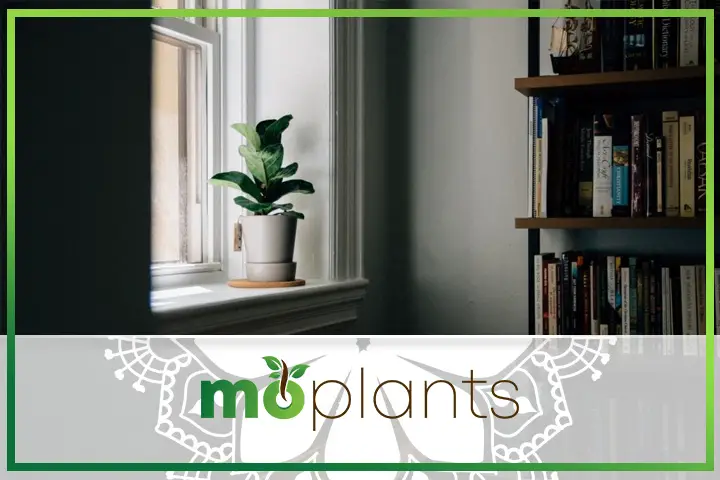
The botanical name for fiddle leaf fig is Ficus lyrata. It belongs to the fig and mulberry Moraceae family.
It is known as fiddle leaf fig because its large glossy leaves are shaped like a violin and support a delicate web of yellowish veins. Moreover, this tropical plant grows upright at a moderately fast pace during its growing season. Therefore, if you are planning to buy this plant for your home, make sure to invest in an elegant floor-standing container that will allow your fiddle leaf fig tree to grow freely while adding to the aesthetic of your home.
Being a tropical plant, fiddle leaf fig flourishes in warm and humid conditions. While it is not a low-maintenance plant, it is pretty forgiving of a less-than-ideal environment. Also, it grows fairly well indoors, as long as you make sure it’s receiving sufficient water and sunlight.
A fiddle leaf fig tree can bear fruits in its natural habitat, though they are not edible. Indoors, it is almost impossible for these plants to produce fruits.
Furthermore, much like other houseplants, fiddle leaf figs also play a vital role in improving indoor air quality by producing oxygen and removing toxins from the environment. In other words, keeping these lovely plants in your living room or bedroom will not only brighten up your space but also keep you healthy and relaxed. It’s a win-win situation.
How to Grow Fiddle Leaf Fig
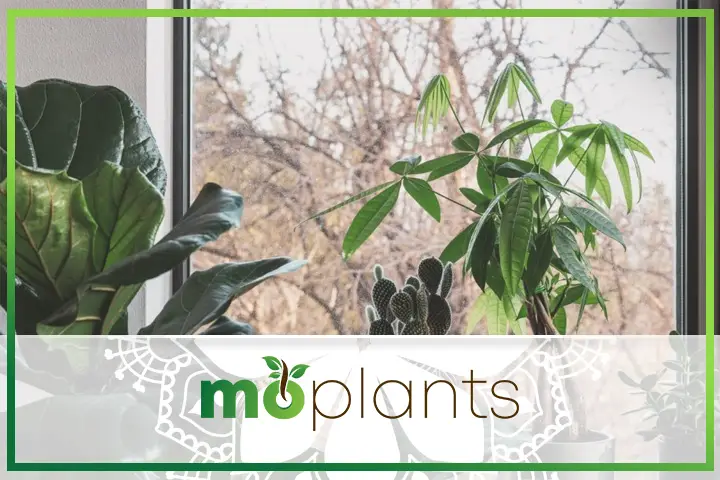
Despite being notorious for its demanding nature, a fiddle leaf fig plant is easy to grow indoors. Here are some useful tips and tricks that will help aspiring gardeners add this beautiful plant to their homes.
Finding the Best Spot
Your fiddle leaf fig plant can only thrive once it finds a perfect home. Since it is a tropical plant, you should consider placing it in a bright spot without direct sunlight. In addition, these houseplants don’t prefer cold drafts or excessive heat, so please make sure they aren’t placed directly in front of an air-conditioner, heater, or window.
The ideal spot for fiddle leaf fig plants is near a window covered with a sheer curtain. Also, make sure not to change its location frequently, as it will hurt the plant’s growth and cause its leaves to drop.
Ideal Temperature
Fiddle leaf figs prefer warm temperatures. The best temperature for these plants is between 65 and 75 degrees Fahrenheit. These plants may develop brown spots during the winter months if the indoor temperature drops below 50 degrees Fahrenheit.
Humidity Level
These statement houseplants thrive in humid climates. For ideal growth, the humidity level in your room should be between 30% and 60%. If the weather is too dry, you can buy a room humidifier, mist the leaves of your fiddle leaf fig plant with water or surround it with other tropical plants to increase humidity.
Placing the planter for fiddle leaf fig trees on top of a water-filled tray of gravel can also help. However, you’ll have to make sure the bottom of the pot doesn’t touch the water, as it may result in root rot.
Exposure to Sunlight
Filtered bright light can keep your fiddle leaf fig shiny and healthy for a long time, though exposure to harsh and direct sunlight can burn its leaves. So, it would help if you consider placing these houseplants near an east-facing window.
Experts also suggest rotating your plant at the same spot at regular intervals. This practice ensures that all leaves of the plant are receiving sufficient sunlight. Also, regular rotations will keep your plant from reaching for the light and growing in one particular direction.
Watering Frequency
Overwatering will kill your fiddle leaf fig plant more quickly than anything else. You should always use room temperature water to prevent the houseplant from going into shock, and please only water it when the top two inches of the soil are completely dry.
If you water the plant too frequently, the roots will begin to rot.
Potting Mix
For lush foliage, use a nutrient-rich potting mix that is also well-aerated. For this purpose, any quality soil for indoor plants would work perfectly. However, you’ll have to make sure the soil drains well.
Propagation
Fiddle leaf fig propagation is relatively simple. First, you will have to find a branch with healthy leaves and cut it right above the leaf node. Then, put the cutting in a pot of water and place it in a well-lit spot. Once the roots begin to develop and grow a few inches long, move the new plant to an appropriate pot.
In ideal circumstances, fiddle leaf fig propagation takes about a month or two.
Infographic
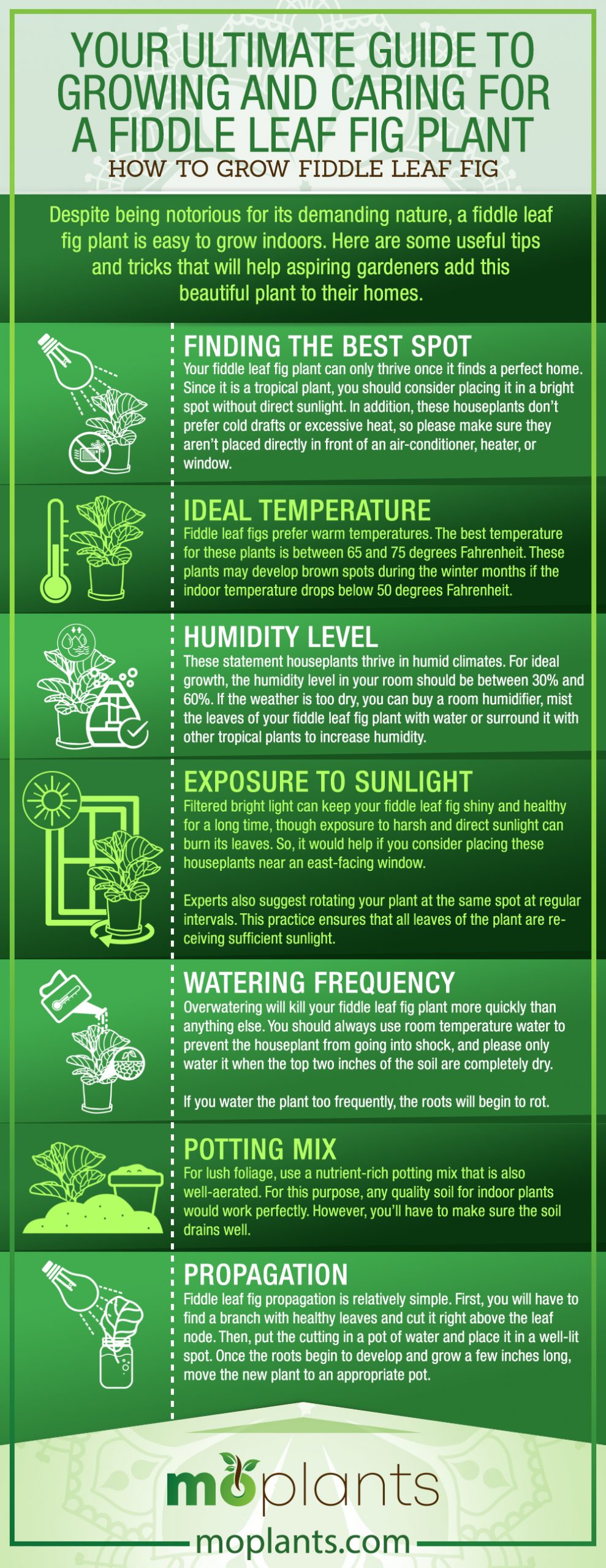
Fiddle Leaf Fig Care Tips
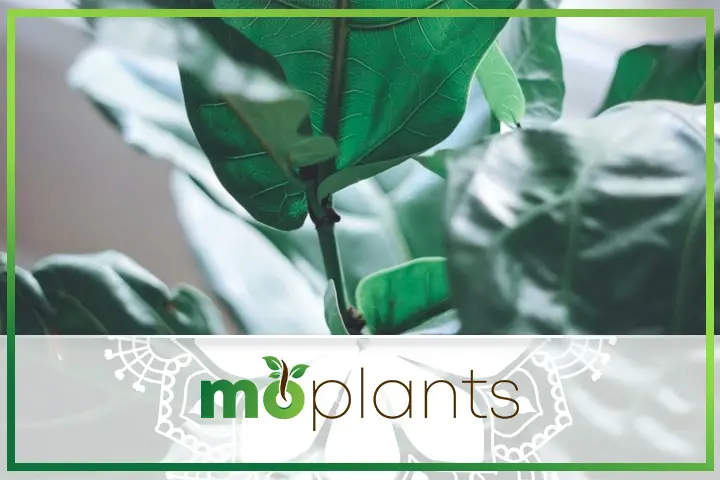
Growing fiddle leaf figs is one thing; caring for them is a different deal. While these plants are not particularly hard to handle, you will have to keep an eye on their growth rate and the condition of their leaves to determine if you need to make some changes to their care routine.
These are some fiddle leaf fig care tips that you may find helpful.
Trimming and Pruning
Removing damaged or dead leaves can promote healthy growth in your fiddle leaf fig plant.
Since these tropical plants grow fast, you should trim the crossing branches to ensure each leaf receives an ample amount of sunlight. You can also prune it every month to make sure the plant doesn’t look out-of-shape or overgrown.
However, always try and cut the branches at least an inch or two away from the main trunk. These practices will keep your plant looking stylish and healthy for a long time.
Prevent Salt Buildup
The high levels of salt in the soil can damage your fiddle leaf fig tree. To prevent this buildup, flush the soil every two months with filtered water. Once the water drains from the bottom of the pot, remove it immediately.
Discard Excess Water
As mentioned above, do not let your fiddle leaf figs sit in water. After you’ve watered the plant and the excess water is collected in the saucer at the bottom, please discard it as soon as possible.
Water-Soluble Fertilizer
You can feed your fiddle leaf fig plants a high-nitrogen diet during the summer months. Purchase any water-soluble fertilizer for houseplants from the market and follow the label instructions to determine the ideal quantity.
Avoid using fertilizers during the dormant winter months.
Wiping and Cleaning
Wiping the dust off your fiddle leaf figs with a damp cloth is a great way to keep them looking shiny and healthy. Getting rid of the dust particles will also allow the plant to produce more oxygen.
Repotting
Fiddle leaf figs can grow out of their pots every year. However, once their roots begin to peek at the bottom of their planter, you should consider moving the plants to another container about two inches larger in diameter.
If the houseplant is too large to be repotted, a good alternative would be to trim the root ball no more than 20 percent and keep it in the same container. You can start by removing the top layer on the soil, trimming the roots, and filling the pot with fresh, nutrient-rich soil.
Infographic
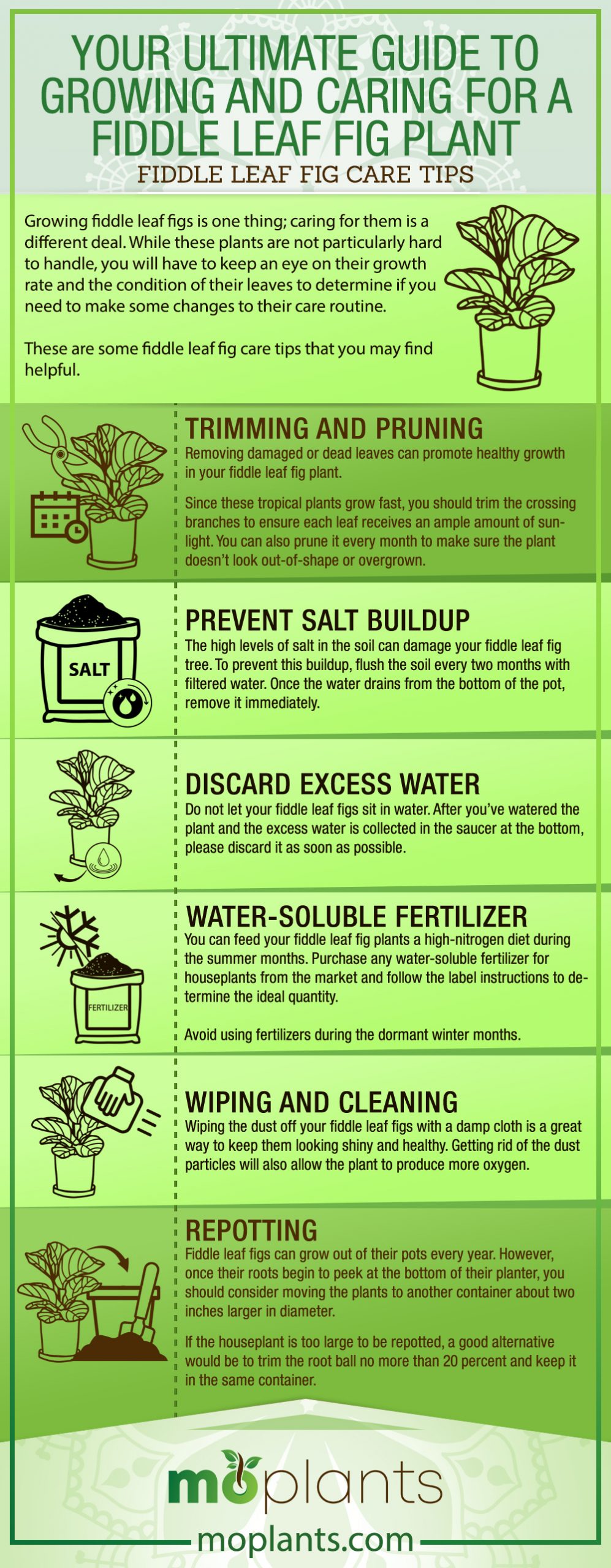
Common Fiddle Leaf Fig Problems and How to Solve Them
With proper maintenance, your fiddle leaf fig plant can continue to grow at a healthy pace.
Let’s take a look at some of the most common problems you may encounter while growing these tropical plants and how you can troubleshoot them.
Pest Infestation
If you notice any holes or discolored patches in your houseplant leaves, there is good chance pests have infested them. You can also check the underside of each leaf and look for any abnormal growths to confirm your suspicion.
Since these plants are prone to aphids, mealy bugs, and mites, among other critters, keeping a mild insecticidal soap at hand is a good idea.
Leaves with Brown Edges
Is your fiddle leaf fig plant developing brown edges? If so, it is likely an indicator that you are watering your plant more than needed. To fix this problem, avoid watering the plant unless the top inch of the soil is completely dry.
Leaves with Brown Spots
Distinct brown spots on the fiddle leaf fig plant may signify that you are not watering your plant enough. These spots also form on the leaves if they receive direct sunlight for long periods or if the temperature is too cold for them.
To counter this problem, adjust your home’s temperature accordingly. It would be best if you also covered the windows in your room with a sheer curtain to keep the plant from dying.
Dropping Leaves
There can be several reasons associated with this problem. However, the most common reason behind leaves falling off the plant is lack of care and attention. It would help if you considered making a schedule to ensure you are not overwatering or underwatering the plant. Similarly, bad weather conditions and too much exposure to bright light can also result in the fiddle leaf fig plant losing its foliage.
Is Fiddle Leaf Fig Toxic?
Yes, fiddle leaf figs can be toxic to pets and small children. However, the poisoning caused by this houseplant is not fatal.
These tropical plants have a white sap containing tiny calcium oxalate crystals coursing through their stem and branches. If your pet or children come in contact with this substance, it can cause blisters to appear on their skin. Meanwhile, biting the leaf of this plant or ingesting the sap can be much more harmful than merely touching it.
If you touch the sap while pruning or trimming your fiddle leaf fig tree, please make sure not to touch your eyes or mouth.
Symptoms of Fiddle Leaf Fig Poisoning
In case your pet or toddler takes a bite of the plant or ingest its sap, they are likely to exhibit the following symptoms:
- Rashes and blisters on the skin
- Oral irritation
- Drooling
- Swollen mouth
- Reduced appetite
- Nausea
- Vomiting
- Diarrhea
- Difficulty in problem
In situations like this, please consult a physician or veterinarian as soon as possible.
Varieties of Fiddle Leaf Fig
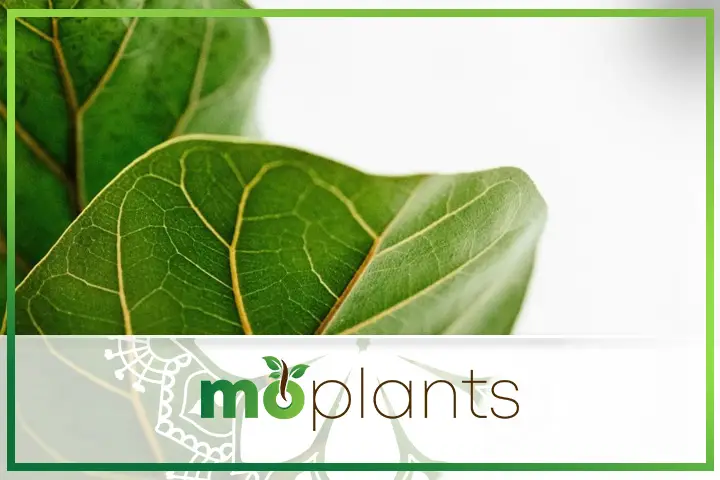
These are some of the most well-known types of fiddle leaf figs.
Ficus lyrata ‘Bambino’
Ficus lyrata’ Bambino’ is a dwarf variety of fiddle leaf figs that only grow a few feet tall. They are compact, bushier, and upright with thicker, leathery leaves. You can easily put these plants in small, decorative pots and place them on your desk, window sill, shelf, or nightstand.
Ficus lyrata ‘Compacta’
This variety of fiddle leaf figs can only grow as tall as 5 feet. These houseplants usually have a more bunched appearance with a glossy sheen and noticeable veins. For proper growth, you should water this indoor plant about two times a week and keep it in a bright spot.
Ficus lyrata ‘Variegata’
Ficus lyrata’ Variegata’ is a rare variety of fiddle leaf figs with creamy white or olive green variegations. Unfortunately, these plants are not available easily, but they are exquisite to look at and can be a charming addition to your home.
Fiddle Leaf Fig FAQs
Let’s look at some of the most frequently asked questions about fiddle leaf fig care and growth.
How to choose the best planter for fiddle leaf fig plants?
Ideally, the planter for fiddle leaf fig plants should be about two inches bigger than the root ball. For fiddle leaf fig propagation, start with a smaller container before gradually moving to a bigger size.
Is it hard to keep a fiddle leaf fig tree alive?
The tropical houseplant requires proper care and upkeep. Otherwise, its leaves will lose their shine and begin to drop. However, fiddle leaf figs deal well with not-so-perfect climate conditions and can survive for years indoors.
Can fiddle leaf fig plants tolerate low light?
Fiddle leaf figs don’t require direct natural light to thrive. However, if you don’t have any other option but to place the plant in a relatively dark corner of your home, please make sure all the leaves get an equal amount of light. Also, you will have to be more careful while watering and fertilizing the plant.
To conclude, a fiddle leaf fig plant can make your interior décor appear more luxurious and elegant. It also has incredible air purifying properties that will keep your indoor environment fresh and healthy. You can place these houseplants near an open window away from an air conditioner to promote faster growth. Also, investing in a humidifier can be a great idea if you want the plant to flourish and stay alive for years to come.

